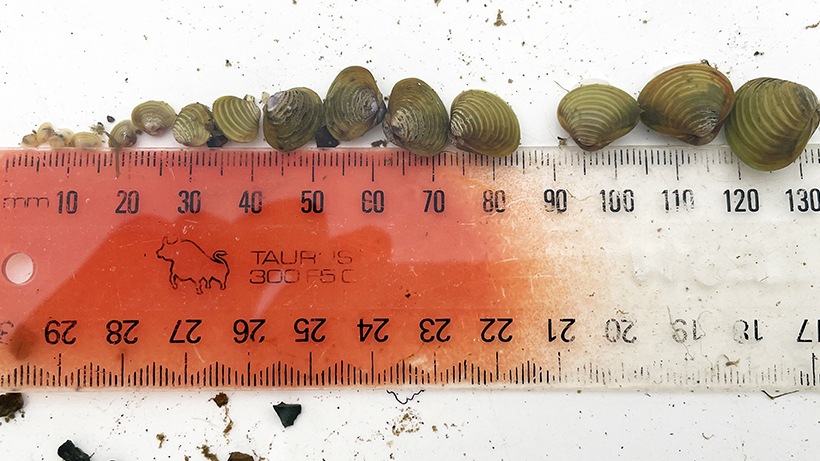On the water this weekend?
The Ministry for Primary Industries needs our help to keep an eye out for a new-to-New Zealand clam species that was recently discovered in the Waikato River at Bob's Landing near Lake Karāpiro.
The invasive freshwater gold clam was found in Waikato River and could be between Bob's Landing near Lake Karāpiro and Wellington Street Beach in Hamilton.
These distinctive clams can be found within the water, sitting on top of sandy or muddy surfaces, or buried shallowly within them. They're quite distinctive – there are no New Zealand species that look like this in the river.
The clams reproduce rapidly and form large populations that can clog water-based infrastructure such as electric generation plants, irrigation systems, and water treatment plants.
They are filter feeders that can potentially compete with native species for food.
"We do not yet know how this species will respond in New Zealand conditions," says a Ministry of Primary Industries spokesperson.

Freshwater gold clams from the Waikato River with ruler for scale. Photo: NIWA
'It is hugely disappointing that this invasive species has been discovered in the river, which is a vital source of life for such a large part of our rohe," says Waikato Regional Council Chief Executive Chris McLay.
'It's been found over an especially popular stretch of the river. Lake Karāpiro alone has 50 days of events every year that attract thousands of competitors, and through summer our maritime officers can find hundreds of boats, jet skis and kayaks using the lake on any given day. Even in winter it continues to be heavily used.
'It's possibly one of the most busy and congested stretches of inland water in New Zealand.
'To protect our precious waterways – not just here in the Waikato region, but right around New Zealand – we strongly urge water users to make sure they're following the Check Clean Dry approach. It will be vital to stopping the spread of this species elsewhere."
Waikato Regional Council is taking guidance from Biosecurity New Zealand and supporting the national response that's now underway under their leadership.
If you fish, boat or row in the Waikato River, this situation is a reminder to 'Check Clean Dry' to help stop the possible spread of the freshwater gold clam.
To help identify the species, there is full information, including clear images of the clam, on the Biosecurity New Zealand website at: biosecurity.govt.nz/clam.
Suspected sightings can be reported to Biosecurity New Zealand on 0800 80 99 66 or by completing the online reporting form at report.mpi.govt.nz. It is helpful to note the precise location and provide a close-up photo of the clam as well as one that shows the surroundings. Please do not disturb the organism.
Check
Remove any visible matter, including any clams you can see, along with plant material or mud. Drain all river water.
Clean
Do a washdown of your gear and watercraft with tap-water onto grass, beside the waterway or at home and not into a stormwater drain system. This will flush off clam larvae, which can be too small to be seen.
For gear made of absorbent materials, which will stay wet longer, apply a cleaning treatment.
Dry
Allow gear to dry to touch, inside and out, then leave it to dry for at least 5 days.
Dry areas inside the watercraft where water has pooled, for example with an old towel, and then leave the craft to dry for at least five days. The hull of a watercraft will dry when towed.
If you spot any clams, please note the location and call Biosecurity New Zealand on 0800 80 99 66 or complete the online reporting form here: https://report.mpi.govt.nz/pest/
For more information visit: www.mpi.govt.nz/clam

.jpg)

0 comments
Leave a Comment
You must be logged in to make a comment.